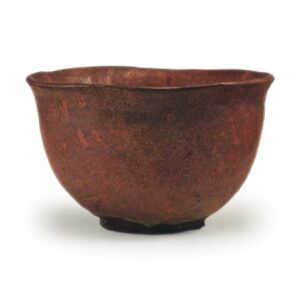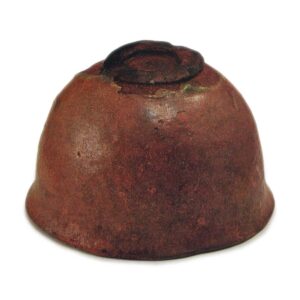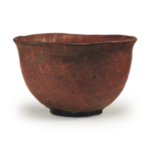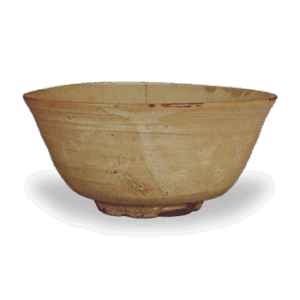

Height: 8.6-8.9cm
Diameter: 14.0cm
Outer diameter of foot ring: 5.4-6.0cm
Height of foot ring: 0.6cm
This is a type of tea bowl known as a different style of work by Chojiro, and is called the Kumagawa style. Compared to the standard Chojiro style, it is thinner, with a curved rim and a round body. The clay is red Jyurakudo, and it has a slightly devitrified, matte Chinese clay glaze, and the color of the skin is a reddish purple, so at first glance it looks like a Shikuma River ware. The glaze is carelessly applied, and the foot ring is exposed, flat and smooth, as if it had been stroked with a fingertip. Also, the inside of the foot ring is slightly shaped like a swastika.
The name of the tea bowl, “Dōjōji”, is a reference to the way the bowl resembles a bell when it is turned upside down, and the wabi-cha aesthetic is further enhanced by the addition of color, as well as the addition of a haiku poem by Hara no Sōsui. Furthermore, there is a bead-like pool in the center of the bowl, and there is also a bead-like pool on the edge of the glaze on the side of the foot, creating a scene rich in elegance.
What is particularly noteworthy about this tea bowl is its unique style, which could be called Koetsu-style, and the characteristics of which are similar to those of Honchojiro, as described by Koike Michioku. The rounded shape and flat foot ring are the origins of the Koetsu style, and can be seen here. Judging from the style and glaze, Dojoji is probably an early work by Chojiro. In addition, the foot ring is lacquered.
Traditionally, Kotatsu was famous as a tea bowl by Chojiro, but it was not considered very important by the traditional tastes of the tea ceremony world, as it was very different from the type of tea bowls made by Chojiro Tsuudo. In recent years, as research into Chojiro has deepened, and in relation to the issue of the creation of Raku tea bowls, this type of work has suddenly come to be noticed, and Dojoji has also suddenly appeared in this field, encouraged by this momentum. The naive style of these works, which predate the so-called Chojiro style, even has a flamboyant feel to it, and it reminds us of the discovery of a new charm in Chojiro. Koetsu was also attracted by this charm and, inspired by it, he probably created his new style of pottery, but we must also praise the free aesthetic eye of Soetsu, who took this up and gave it the appropriate name of Dojoji. Furthermore, the discernment of Toda Rosho, who was at the heart of the tea ceremony world and paid close attention to this unique tea bowl, and of Kameida Korian, a tea ceremony master who acquired it with his excellent taste despite being within the walls of tradition, must also be respected. Accessories
Inner box: Satsuma cedar, plain wood, with inscription on the underside of the lid by Sōtan: “Dojoji, Tōtōsai (signature)”
Outer box: Paulownia wood, plain wood, with inscription on the underside of the lid by Sōtan: “Chōjirō ware, red tea bowl, Sōtan inscription, Dojoji, left (signature)”
The sound of the bell is like that of the bell at Dojoji Temple, and this is the name of the tea bowl that is famous for its sound.”
Attached note: one letter, Toda Rosho
It was passed down from Sotan and Roso to the Matsudaira family, who were famous for possessing many famous tea bowls, and was later owned by the Matsudaira family of Ueda Castle in Shinshu, but in the first year of the Taisho era, when the family’s possessions were sold off, it came into the possession of the Tanimatsuya (Gen’an Rosho) and later became the treasured property of Kameda Korian of Kanazawa, and after the war it came into the possession of a certain family in the Kansai region, where it remains to this day.








